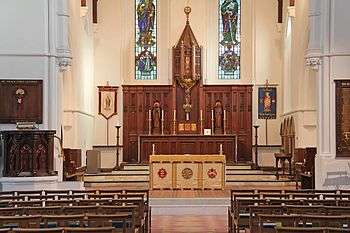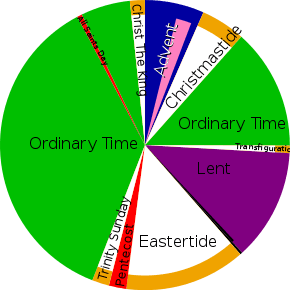Mothering Sunday
| Mothering Sunday | |
|---|---|
| Observances | Visiting the church in which one was baptised, honouring one's mother |
| Date | 4th Sunday in Lent |
| 2017 date | 26 March |
| 2018 date | 11 March[1] |
| 2019 date | 31 March |
| 2020 date | 22 March |
| Frequency | Annual |
| Related to | Laetare Sunday, Lent |
Mothering Sunday is a holiday celebrated by Catholic and Protestant Christians in the UK and some other parts of the world. It is generally observed in parishes of the Church of England, as well as in the rest of the UK and many Anglican parishes throughout the world, especially in Canada and Australia. It falls on the fourth Sunday in Lent, exactly three weeks before Easter Day. Once observed as a day on which people would visit their "mother" church, it has become an occasion for honouring the mothers of children and giving them presents.[2] It is increasingly being called Mother's Day, although that name properly belongs to the American holiday which is quite distinct from the original Mothering Sunday.[2] In the UK and the Republic of Ireland, Mothering Sunday is celebrated in a similar way as Mother's Day is celebrated in the USA.
History

During the 16th century, people returned to their mother church for a service to be held on Laetare Sunday;[3] in this context, one's 'mother church' was either the church where one was baptised, or the local parish church, or the nearest cathedral (the latter being the mother church of all the parish churches in a diocese).[2] Anyone who did this was commonly said to have gone "a-mothering", although whether this term preceded the observance of Mothering Sunday is unclear. In later times, Mothering Sunday became a day when domestic servants were given a day off to visit their mother church, usually with their own mothers and other family members.[3] It was often the only time that whole families could gather together, since on other days they were prevented from doing so by conflicting working hours.[4]
Children and young people who were "in service" (as household servants) were given a day off on that date so they could visit their families (or, originally, return to their "mother" church). The children would pick wild flowers along the way to place in the church or give to their mothers.[5] Eventually, the religious tradition evolved into the Mothering Sunday secular tradition of giving gifts to mothers.[2]
By the 1920s the custom of keeping Mothering Sunday had tended to lapse in Ireland and in continental Europe.[6] In 1914, inspired by Anna Jarvis's efforts in the United States, Constance Penswick-Smith created the Mothering Sunday Movement,[7] and in 1921 she wrote a book advocating the revival of the festival; Constance was the daughter of the vicar of Coddington, Nottinghamshire, and there is a memorial in Coddington's church.[8][9] The traditions of Mothering Sunday, still practised by the Church of England and Church of Ireland were merged with the newly imported traditions and celebrated in the wider Catholic and secular society.[6][10][11] UK-based merchants saw the commercial opportunity in the holiday and relentlessly promoted it in the UK; by the 1950s, it was celebrated across all the UK.[10]
People in Ireland and the UK celebrate Mothering Sunday on the fourth Sunday in Lent; the day is also referred to sometimes as Mid-Lent Sunday and seen as a day when the austerity of Lent is temporarily put aside.[6] [4]
Mothering Sunday remains in the calendar of some Canadian Anglican churches, particularly those with strong English connections.
Names
| Year | Date |
|---|---|
| 2012 | 18 March |
| 2013 | 10 March |
| 2014 | 30 March |
| 2015 | 15 March |
| 2016 | 6 March |
| 2017 | 26 March |
| 2018 | 11 March[1] |
| 2019 | 31 March |
| 2020 | 22 March |
| 2021 | 14 March |
| 2022 | 27 March |
| 2023 | 19 March |
| 2024 | 10 March |
| 2025 | 30 March |
| 2026 | 15 March |
The other names attributed to the fourth Sunday in Lent include Refreshment Sunday, Pudding Pie Sunday (in Surrey, England), Mid-Lent Sunday,[12] Simnel Sunday and Rose Sunday. Simnel Sunday is named after the practice of baking simnel cakes to celebrate the reuniting of families during the austerity of Lent. Because there is traditionally a relaxation of Lenten vows on this particular Sunday in celebration of the fellowship of family and church, the name Refreshment Sunday is sometimes used, although rarely today.
Rose Sunday is sometimes used as an alternative title for Laetare Sunday, as is witnessed by the purple robes of Lent being replaced in some churches by rose-coloured ones. The 1913 Catholic Encyclopedia asserts that "the Golden Rose, sent by the Popes to Catholic sovereigns, used to be blessed at this time, and for this reason the day was sometimes called 'Dominica de Rosa'."[13][14]
This Sunday was also once known as the "Sunday of the Five Loaves", from the traditional Gospel reading for the day. Prior to the adoption of the modern "common" lectionaries, the Gospel reading for this Sunday in the Anglican, Roman Catholic, Western-Rite Orthodox, and Old Catholic churches was the story of the feeding of the five thousand (for instance, the Anglican Book of Common Prayer stipulates St John's Gospel 6:5–14).
Other
The Epistle for the fourth Sunday in Lent as set out in the Book of Common Prayer and The 1962 Missal of the Roman Catholic Church give a special place to the theme of maternal love: Galatians 4:26 states that "Jerusalem which is above is free; which is Mother of us all."[2]
Another tradition associated with Mothering Sunday is the practice of "clipping the church", whereby the congregation form a ring around their church building and, holding hands, embrace it.
For some Church of England churches, it is the only day in Lent when marriages can be celebrated.
During Mothering Sunday services in some churches children in the congregation are given a little bunch of spring flowers to give to their mothers.[12]
Cakes and buns
- Simnel cake is a traditional confection associated with both Mothering Sunday and Easter.[15]:page 2
- Around 1600, when the celebration was only held in England and Scotland, a different kind of pastry was preferred.
- In England, "Mothering Buns" or "Mothering Sunday Buns" were made to celebrate. These sweet buns are topped with pink or white icing and the multi-coloured sprinkles known as "hundreds and thousands" in the UK. They are not widely made or served today in the UK but in Australia they are a bakery staple, not related to any particular celebration.
- In Northern England and Scotland some preferred "Carlings", pancakes made of steeped peas fried in butter.[16]
See also
- Father's Day
- Homecoming
- Laetare Sunday (cf. Gaudete Sunday)
- Matronalia, dedicated to the fertility of married women
- Mother's Day
References
- 1 2 Moveable date calculations by Module:Easter – via
{{Calendar date}} - 1 2 3 4 5 "Mothering Sunday", BBC, retrieved 4 March 2010
- 1 2 Cross F.L. & Livingstone E.A. (1974), "Mothering Sunday", Oxford Dictionary of the Christian Church, OUP
- 1 2 David Self (1993), One hundred readings for assembly, Heinemann Assembly Resources, Heinemann, pp. 27–29, ISBN 9780435800413
- ↑ Hop, Studio (2018). "The Evolution of Mothers Day". Studio Hop. Retrieved 2018-05-22.
- 1 2 3 Irish Culture and Customs, Bridget Haggerty
- ↑ Archives suisses des traditions populaires (Schweizerische Gesellschaft für Volkskunde), 52, 1956
- ↑ Michael Bache, Mothering Sunday. Constance Penswick Smith – (1878–1938), Coddington (Notts) History Group, archived from the original on 3 April 2012
- ↑ The revival of Mothering Sunday,: Being an account of the origin, development, and significance of the beautiful customs which have entwined themselves … true and ancient day in praise of mothers, Macmillan Publishers, 1921, ASIN B00086O8I6
- 1 2 Ronald Hutton (2001), The stations of the sun: a history of the ritual year in Britain (illustrated, reprinted ed.), Oxford University Press, pp. 174–177, ISBN 0-19-285448-8
- ↑ Owen Spencer-Thomas, How Mothering Sunday became Mother's Day, Diocese of Ely
- 1 2 Mandy Barrow (2010), Mothering Sunday. The UK's version of Mother's Day, woodlands-junior.kent.sch.uk (original location)
- ↑ Catholic Encyclopedia (1913)
- ↑ "CATHOLIC ENCYCLOPEDIA: Golden Rose".
- ↑ "Mothering Sunday". Religion & Ethics. bbc.co.uk. Retrieved 28 May 2006.
- ↑ 簡世華 (2005). 寂天文化, ed. Western Holidays and Festivals / Jie qing Ying yu yuan lai ru ci (in Chinese and English). Taibei Shi: Ji tian wen hua shi ye you xian gong si. p. 133. ISBN 9789575856755.
